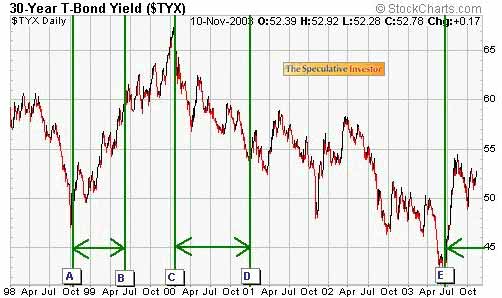




Why the Fed
will have to hike
Steve Saville
14 November, 2003
Extracted
from commentary posted at www.speculative-investor.com on 13
November 2003: In the 22nd October Interim
Update we explained why we think the Fed will have to hike official
interest rates over the coming 12 months by more than the market
is presently anticipating. Then, in the 29th October Interim
Update, we predicted that the Fed would begin talking about the
risks of rising inflation by the 28th January FOMC Meeting. We
are now going to revisit this matter because it is so important
and because we perceive a large mismatch between the consensus
view and what is actually going to happen.
Many of our readers would be
familiar with John Mauldin and his free newsletter that gets
sent out to literally millions of people each week. Mr Mauldin
doesn't expect the Fed to raise interest rates at all over the
coming year so his view could not be described as typical (the
consensus view is that there will be a modest increase in rates).
However, his reasons for not expecting any rate hikes from the
Fed are representative of the wrong-headed thinking that appears
to be dominating interest rate discussions.
If you haven't already done
so we suggest that you read Mr Mauldin's latest
analysis for a 'take' on why the Fed won't hike next year.
In summary, the argument is that a) the Fed wants to see sustainable
employment growth before hiking rates, and b) the Fed is going
to buy insurance for a growing economy in the form of lower rates
until after the November 2004 elections.
These arguments would be valid if the short-term interest rate
set by the Fed controlled the long-term interest rates set by
the market, that is, if keeping the Fed Funds Rate at a very
low level guaranteed that long-term interest rates would remain
low. In the real world, though, the opposite is true in that
the Fed is typically dragged along, 'kicking and screaming',
by the bond market.
We've attempted to illustrate the lead-lag relationship between
the bond market and the Fed on the below chart of the 30-year
bond yield.

Point A on the chart corresponds
to the time when the trend for long-term interest rates turned
higher in October of 1998 while point B corresponds to the time
when the Fed began to hike short-term rates (June 1999). The
difference between the two points -- 9 months -- represents the
time it took the Fed to respond to the changing financial/economic
environment.
Point C on the chart corresponds to the time when the trend for
long-term interest rates turned lower in January of 2000 while
point D corresponds to the time when the Fed began to cut short-term
rates (January 2001). The difference, in this case, was 12 months.
Currently, 5 months have gone by since long-term interest rates
turned higher (point E on the chart). If the Fed follows the
bond market with the same 9-12 month lag that characterised the
past two major monetary-policy shifts then the first rate-hike
will happen between March and June of next year.
We expect that the first official rate hike will occur by March
2004 and that the Fed will be FORCED to hike rates aggressively
during the 6 month period leading up to the November 2004 presidential
election. The reason they will be forced to hike rates is that
once inflation expectations get out of hand -- something that
has a good chance of happening next year due to the excessively
easy monetary policies of the past year -- it becomes counter-productive
NOT to do so. This is because long-term interest rates are pushed
higher by rising inflation expectations and long-term interest
rates have a much greater effect on the stock market, the real
estate market and the economy than do short-term interest rates.
As such, at some point in the inflation cycle it becomes necessary
to increase official short-term interest rates in order to quell
the inflation fears and bring down long-term interest rates.
Further to the above, the argument that short-term interest rates
will remain low because the Fed wants them to remain low makes
no sense. The Fed will only have the option of keeping short-term
interest rates low for as long as long-term interest rates remain
near current low levels. And long-term interest rates will only
remain near current low levels for as long as inflation expectations
remain subdued. However, if we are right about what is going
to happen to the gold price, to commodity prices in general and
to the US$ over the next year then inflation expectations are
absolutely NOT going to remain subdued.
Funnily enough, whether or not the Fed ends up having the option
of keeping short-term interest rates near current low levels
for much longer will be determined, to a large extent, by the
actions of the Chinese and Japanese monetary authorities. There
are two reasons for this. First, the credit expansion that is
raging away in China is causing that country's demand for commodities
to ramp-up at a staggering pace. Unless the Chinese authorities
are successful in slowing the credit expansion and the resultant
credit-induced boom within the next few months, the CRB Index
will burst above its 1996 peak and begin heading towards its
1980 peak at a rapid rate. It doesn't take much imagination to
realise that this would put enormous downward pressure on bond
prices (upward pressure on long-term interest rates) throughout
the world. Second, long-term US interest rates would already
be much higher if not for the huge purchases of US Treasury Bonds
and Agency Securities made by the central banks of Japan and
China over the past year,
 Steve Saville Steve Saville
email: sas888_hk@yahoo.com
Hong Kong
14 November, 2003
Regular financial market forecasts
and analyses are provided at our web site:
http://www.speculative-investor.com/new/index.html
One-month free trial available.
Copyright
©2002-2003 speculative-investor.com All Rights Reserved
______________
321gold Inc ref: 05304

|